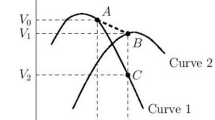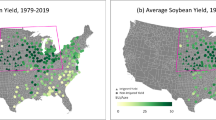Abstract
The United States is one of the largest soybean exporters in the world. Production is concentrated in the upper Midwest1. Much of this region is not irrigated, rendering soybean production systems in the area highly sensitive to in-season variations in weather. Although the influence of in-season weather trends on the yields of crops such as soybean, wheat and maize has been explored in several countries2–6, the potentially confounding influence of genetic improvements on yields has been overlooked. Here we assess the effect of in-season weather trends on soybean yields in the United States between 1994 and 2013, using field trial data, meteorological data and information on crop management practices, including the adoption of new cultivars. We show that in-season temperature trends had a greater impact on soybean yields than in-season precipitation trends over the measurement period. Averaging across the United States, we show that soybean yields fell by around 2.4% for every 1 °C rise in growing season temperature. However, the response varied significantly among individual states, ranging from −22% to +9%, and also with the month of the year in which the warming occurred. We estimate that year-to-year changes in precipitation and temperature combined suppressed the US average yield gain by around 30% over the measurement period, leading to a loss of US$11 billion. Our data highlight the importance of developing location-specific adaptation strategies for climate change based on early-, mid- and late-growing season climate trends.
This is a preview of subscription content, access via your institution
Access options
Subscribe to this journal
Receive 12 digital issues and online access to articles
$119.00 per year
only $9.92 per issue
Buy this article
- Purchase on Springer Link
- Instant access to full article PDF
Prices may be subject to local taxes which are calculated during checkout


Similar content being viewed by others
References
USDA-NASS. 2014. Quick Stats 2.0.USDA-NASS, Washington, DC. www.nass.usda.gov/quickstats/ (accessed 20 April 2014).
Nicholls, N. Increased Australian wheat yield due to recent climate trends. Nature 387, 484–485 (1997).
Lobell, D. B. & Asner, G. P. Climate and management contributions to recent trends in U.S. agricultural yields. Science 299, 1032 (2003).
Lobell, D. B. & Field, C. B. Global scale climate-crop yield relationships and the impacts of recent warming. Environ. Res. Lett. 2, 014002 (2007).
Brinsson, N. P. et al. Why are wheat yields stagnating in Europe? A comprehensive data analysis for France. Field Crops Res. 119, 201–212 (2010).
Lobell, D. B., Schlenker, W. & Costa-Roberts, J. Climate trends and global crop production since 1980. Science 333, 616–620 (2011).
IPCC Climate Change 2013: The Physical Science Basis. (eds Stocker, T. F. et al.) (Cambridge Univ. Press, 2013).
Tubiello, F. N., Soussana, J-F., Howden, S. M. & Easterling, W. Crop and pasture response to climate change. Proc. Natl Acad. Sci. USA 104, 19686–19690 (2007).
Purcell, L. & Specht, J. E. in Soybeans: Improvement, Production, and Uses 3rd edn (eds Boemma, H. R. & Specht, J. E. ) 569–620 (American Society of Agronomy, 2004).
Changnon, S. A. & Hollinger, S. E. Problems in estimating impacts of future climate change on Midwestern corn yields. Clim. Change 58, 109–118 (2003).
Kucharik, C. J. & Serbin, S. P. Impacts of recent climate change on Wisconsin corn and soybean yield trends. Environ. Res. Lett. 3, 034003 (2008).
Rincker, K. et al. Genetic improvement of US soybean in maturity groups II, III, and IV. Crop Sci. 54, 1419 (2014).
Specht, J. E., Hume, D. J. & Kumudini, S. V. Soybean yield potential – a genetic and physiological perspective. Crop Sci. 39, 1560–1570 (1999).
Specht, J. E. et al. in Yield Gains in Major US Field Crops CSSA. Special Publication 33 (eds Smith, S., Diers, B., Specht, J. & Carver, B. ) Ch. 12, 199–243 (American Society of Agronomy, Crop Science Society of America, Soil Science Society of America, 2014).
Lobell, D. B. et al. Analysis of wheat yield and climatic trends in Mexico. Field Crops Res. 94, 250–256 (2005).
Liu, X., Jian, J. Guanghua, W. & Herbert, S. J. Soybean yield physiology and development of high-yielding practices in Northeast China. Field Crops Res. 105, 157–171 (2008).
Twine, T. E. & Kucharik, C. J. Climate impacts on net primary productivity trends in natural and managed ecosystems of the central and eastern United States. Agric. For. Meteorol. 149, 2143–2161 (2009).
Xu, Z., Hennessy, D. A., Sardana, K. & Moschini, G. The realized yield effect of genetically engineered crops: US maize and soybean. Crop Sci. 53, 735–745 (2013).
Author information
Authors and Affiliations
Contributions
S.M analysed the data, carried out the statistical analysis and wrote the paper. S.P.C., L.E.L., W.J.W., J.R., E.D.N., H.J.K., N.M., and P.L.D. contributed to the data set, reviewed results and commented on the manuscript. S.P.C., J.E.S. and F.J.A contributed to idea development, reviewed results and provided revisions for improvement of the first manuscript draft.
Corresponding author
Ethics declarations
Competing interests
The authors declare no competing financial interests.
Supplementary information
Rights and permissions
About this article
Cite this article
Mourtzinis, S., Specht, J., Lindsey, L. et al. Climate-induced reduction in US-wide soybean yields underpinned by region- and in-season-specific responses. Nature Plants 1, 14026 (2015). https://doi.org/10.1038/nplants.2014.26
Received:
Accepted:
Published:
DOI: https://doi.org/10.1038/nplants.2014.26
This article is cited by
-
U.S. winter wheat yield loss attributed to compound hot-dry-windy events
Nature Communications (2022)
-
Data-driven projections suggest large opportunities to improve Europe’s soybean self-sufficiency under climate change
Nature Food (2022)
-
Advancing agricultural research using machine learning algorithms
Scientific Reports (2021)
-
In-season weather data provide reliable yield estimates of maize and soybean in the US central Corn Belt
International Journal of Biometeorology (2021)
-
Unstable crop yields reveal opportunities for site-specific adaptations to climate variability
Scientific Reports (2020)



